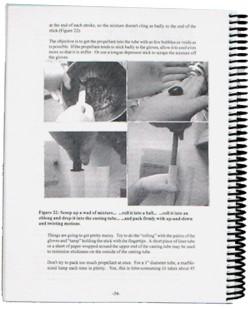CONTENT
 |
| Plenty of "How to" photos like these detailing the mixing and casting of a batch of APCP composite propellant. |
EXPERIMENTAL COMPOSITE PROPELLANT includes:
-
Safety info
-
Motor operation, grain design, and the commonly used technical terms: area ratio, thrust coefficient, burn rate exponent, burn rate coefficient, etc.
-
Simple formulations based on AP/HTPB and AP/PBAN; just four ingredients can make a propellant as powerful as commercial ones
-
Simple propellant that does not require magnesium, aluminum, or burn rate catalyst
-
Density, burn rate coefficient and exponent, and delivered specific impulse results for four TESTED propellants
-
Simple procedures for hand-mixing and processing of propellant WITHOUT vacuum
-
Vacuum procedures for the advanced experimenter.
-
Design of small motors (HPR size).
-
Construction procedure for single-use static test motors and flight motors
-
Description of both commercial and homemade reloadable motors, including machining procedure for forward closures, nozzles, and casings
-
Igniter construction
-
Details on an electronic thrust stand for data collection from your motors
-
Directions for using PROPEP for propellant characterization.
-
An entire section on basic composite propellant chemistry, including explanation and cure calculations for both PBAN and HTPB polymers
-
Mixing and vacuum procedure for HTPB propellant.
-
Information on popular binders, curatives and additives; TDI, MDI, HDI, IPDI, DDI, R45, R20, DER331, plasticizers, crosslinking agents, cure catalysts, burn rate catalysts, thermic agents.
-
Description and use of an alternative, readily-available, lower-viscosity curative for PBAN
-
Results of PROPEP runs for the tested formulations
-
Annotated bibliography
-
A few opinionated essays by various individuals.
This is a must have book that brings together everything necessary to understand making rocket motors. Going through several other books on the subject will not bring understanding and clarity to this subject as fast and as easy.
